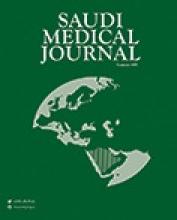Abstract
OBJECTIVE: We aim to examine the spectrum of bacteria causing corneal infections and their antibiotic susceptibility patterns. This will serve as a guideline for empiric therapy of corneal infections.
METHODS: We conducted the study over a period of 18 months from March 2001 through December 2002 in King Abdul-Aziz University Hospital, Riyadh, Kingdom of Saudi Arabia. Corneal specimens taken from 200 patients were inoculated directly onto different types of media. The isolates were identified and then tested against the appropriate topical or systemic antibiotics.
RESULTS: Sixty-seven (33.5%) of the total specimens were culture positive and 133 (66.5%) were culture negative. Fourteen (7%) of these showed organisms in the Gram stained smears and correlated well with the culture reports. Of the 67 positive cultures, 53 (79.1%) were Gram-positive bacteria mostly coagulase-negative Staphylococci 29 (43.3%) followed by Streptococcus pneumoniae (S. pneumoniae) 13 (19.4%). Among Gram-negative bacteria 14 (20.9%), Pseudomonas aeruginosa (P. aeruginosa) 10 (14.9%) was the predominant isolate. All the isolates were sensitive to ofloxacin and the commonly used ocular antibiotics.
CONCLUSION: All the isolated bacteria were sensitive to ofloxacin, a fluoroquinolone. Having marked potency for broad-spectrum activity against both Gram-positive and Gram-negative bacteria, make the fluoroquinolones especially the newer generations, a potential single drug therapy for corneal infections.
- Copyright: © Saudi Medical Journal
This is an open-access article distributed under the terms of the Creative Commons Attribution-Noncommercial-Share Alike 3.0 Unported, which permits unrestricted use, distribution, and reproduction in any medium, provided the original work is properly cited.






